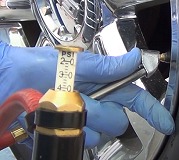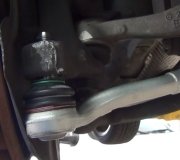Here is some information no the system and how to reset it, this should fix your problem.
TIRE PRESSURE MONITOR OPERATION
This vehicle may have a Tire Pressure Monitor System (TPMS). The TPMS is designed to warn the driver when a low tire pressure condition exists. TPMS sensors are mounted onto each tire and wheel assembly, excluding the spare tire and wheel assembly. The TPMS sensors monitor the air pressure in the vehicle's tires and transmit the tire pressure readings to a receiver located in the vehicle.
When a low tire pressure condition is detected, the TPMS illuminates the low tire pressure warning light located on the instrument panel cluster. If the warning light comes on, stop as soon as possible and inflate the tires to the recommended pressure shown on the Tire and Loading Information Label.
A message to check the pressure in a specific tire displays in the Driver Information Center (DIC). The low tire pressure warning light and the Driver Information Center warning message come at each ignition cycle until the tires are inflated to the correct inflation pressure. Using the Driver Information Center, tire pressure levels can be viewed. For additional information and details about the Driver Information Center operation and displays, see Driver Information Center (DIC) and Tire Messages.
The low tire pressure warning light may come on in cool weather when the vehicle is first started, and then turn off as the vehicle is driven. This could be an early indicator that the air pressure is getting low and needs to be inflated to the proper pressure.
The Tire and Loading Information label shows the size of the original equipment tires and the correct inflation pressure for the tires when they are cold.
The TPMS can warn you about a low tire pressure condition but it does not replace normal tire maintenance.
Notice: Tire sealant materials are not all the same. A non-approved tire sealant could damage the TPMS sensors. TPMS sensor damage caused by using an incorrect tire sealant is not covered by the vehicle warranty. Always use only the GM-approved tire sealant available.
TPMS Malfunction Light and Message
The TPMS will not function properly if one or more of the TPMS sensors are missing or inoperable. When the system detects a malfunction, the low tire warning light flashes for about one minute and then stays on for the remainder of the ignition cycle. A Driver Information Center warning message is also displayed. The low tire warning light and Driver Information Center warning message come on at each ignition cycle until the problem is corrected. Some of the conditions that can cause the malfunction light and Driver Information Center message to come on are:
One of the road tires has been replaced with the spare tire. The spare tire does not have a TPMS sensor. The malfunction light and the Driver Information Center message should go off after the road tire is replaced and the sensor matching process is performed successfully. See "TPMS Sensor Matching Process" later in this section.
The TPMS sensor matching process was not done or not completed successfully after rotating the tires. The malfunction light and the Driver Information Center message should go off after successfully completing the sensor matching process. See "TPMS Sensor Matching Process" later in this section.
One or more TPMS sensors are missing or damaged. The malfunction light and the Driver Information Center message should of off when the TPMS sensors are installed and the sensor matching process is performed successfully.
Replacement tires or wheels do not match the original equipment tires or wheels. Tires and wheels other than those recommended for your vehicle could prevent the TPMS from functioning properly.
Operating electronic devices or being near facilities using radio wave frequencies similar to the TPMS could cause the TPMS sensors to malfunction.
If the TPMS is not functioning properly, it cannot detect or signal a low tire condition.
TPMS Sensor Matching Process
Each TPMS sensor has a unique identification code. The identification code needs to be matched to a new tire/wheel position after rotating vehicle's tires or replacing one or more of the TPMS sensors. Also, the TPMS sensor matching process should be performed after replacing a spare tire with a road tire containing the TPMS sensor. The malfunction light and the Driver Information Center message should go off at the next ignition cycle. The sensors are matched to the tire/wheel positions, using a TPMS relearn tool, in the following order: driver side front tire, passenger side front tire, passenger side rear tire, and driver side rear.
There are two minutes to match the first tire/wheel position, and five minutes overall to match all four tire/wheel positions. If it takes longer, the matching process stops and must be restarted.
The TPMS matching process is:
1. Set the parking brake.
2. Turn the ignition switch to ON/RUN with the engine off.
3. Press the Remote Keyless Entry (RKE) transmitter's and buttons at the same time for approximately five seconds. The horn sounds twice to signal the receiver is in relearn mode and TIRE LEARNING ACTIVE message displays on the Driver Information Center screen.
4. Start with the driver side front tire.
5. Place the relearn tool tool against the tire sidewall, near the valve stem. Then press the button to activate the TPMS sensor. A horn chirp confirms that the sensor identification code has been matched to this tire and wheel position.
6. Proceed to the passenger side front tire, and repeat the procedure in Step 5.
7. Proceed to the passenger side rear tire, and repeat the procedure in Step 5.
8. Proceed to the driver side rear tire, and repeat the procedure in Step 5. The horn sounds two times to indicate the sensor identification code has been matched to the driver side rear tire, and the TPMS sensor matching process is no longer active. The TIRE LEARNING ACTIVE message on the Driver Information Center display screen goes off.
9. Turn the ignition switch to LOCK/OFF.
10. Set all four tires to the recommended air pressure level as indicated on the Tire and Loading Information Label.
Let us know what happens and please upload pictures or videos of the problem.
Tuesday, October 18th, 2022 AT 6:01 PM



